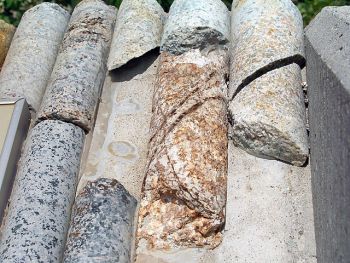Coring: Difference between revisions
Rmanwaring (talk | contribs) No edit summary |
Rmanwaring (talk | contribs) No edit summary |
||
| Line 23: | Line 23: | ||
{{Document Icon}} [[National Engineering Handbook: Chapter 5 - Engineering Geology Logging, Sampling, and Testing | National Engineering Handbook: Chapter 5 - Engineering Geology Logging, Sampling, and Testing (NRCS, 2012)]] | {{Document Icon}} [[National Engineering Handbook: Chapter 5 - Engineering Geology Logging, Sampling, and Testing | National Engineering Handbook: Chapter 5 - Engineering Geology Logging, Sampling, and Testing (NRCS, 2012)]] | ||
{{Document Icon}} [[Earth Manual Part 1 | Earth Manual Part 1 (USBR, 1998)]] | {{Document Icon}} [[Earth Manual Part 1 | Earth Manual Part 1 (USBR, 1998)]] | ||
{{Document Icon}} [[Technical Memorandum 8530-2021-03 Concrete and Rock Core Handling Guide | Technical Memorandum 8530-2021-03 Concrete and Rock Core Handling Guide (USBR, 2021)]] | |||
<!-- In the location of an in text citation, simply enclose the citation as follows: <ref> citation </ref>. Citations will automatically populate. Learn more at https://www.mediawiki.org/wiki/Help:Cite. --> | <!-- In the location of an in text citation, simply enclose the citation as follows: <ref> citation </ref>. Citations will automatically populate. Learn more at https://www.mediawiki.org/wiki/Help:Cite. --> | ||
{{Citations}} | {{Citations}} | ||
<!-- Revision history information --> | <!-- Revision history information --> | ||
{{revhistinf}} | {{revhistinf}} | ||
Revision as of 21:28, 2 November 2022

|
| Rock Core Samples |
Rock coring is used to obtain in-situ rock / soil samples and strength parameters through tests such as the Standard Penetration Test (SPT). "Cylinder samples from 4 to 8 inches in diameter and 6 to 12 inches long... may also be obtained by jacking or otherwise pushing drive samples into exposed surfaces using a continuous steady pressure. Hydraulic power equipment may also be used to push Shelby tubes into exposed undisturbed soil to collect undisturbed samples, such as the sampler mounted on a backhoe."[1]
"Rock core drilling is accomplished with mechanical, engine-powered rotary drills designed to drill rock and to recover cylindrical cores of rock material. Most core drilling equipment is designed with gear or hydraulically driven variable-speed hollow-spindle rotary drill heads. Average core-diameter capability of these drills ranges from 19 to 85 mm (3/4 to 3-3/8 in) and to 300-m (1,000-ft) depths. Larger-diameter coring operations [100 to 150 mm (4 to 6 in)] are usually performed using rotary drills, and cores to 1.8 m (6 ft) in diameter can be drilled and recovered using a shot/calyx drill."[2]
"All core drills are equipped with pumps or compressors to circulate drill media through use of water, drilling mud, air, or air-foam to cool and lubricate the coring bits and to transport the drill cuttings to the top of the hole. Most core drills are equipped with a mast assembly, powered hoist assembly for hoisting heavy loads, and, sometimes, a wire-line hoist assembly for hoisting or lowering a wire-line core barrel through the drill rods."[2]
"Many variations are available in design and mountings for drill rigs manufactured specifically for coring; however, there are only two types basic types. They are conventional or wire-line core drills, for drilling and recovering cores up to 150 mm (6 in) in diameter, and shot/calyx core drills for drilling, and recovering cores to 1.8 m (6 ft) in diameter."[2]
Best Practices Resources
![]() Earth Manual Part 1 (USBR, 1998)
Earth Manual Part 1 (USBR, 1998)
![]() Technical Memorandum 8530-2021-03 Concrete and Rock Core Handling Guide (USBR, 2021)
Technical Memorandum 8530-2021-03 Concrete and Rock Core Handling Guide (USBR, 2021)
Citations:
Revision ID: 4082
Revision Date: 11/02/2022
